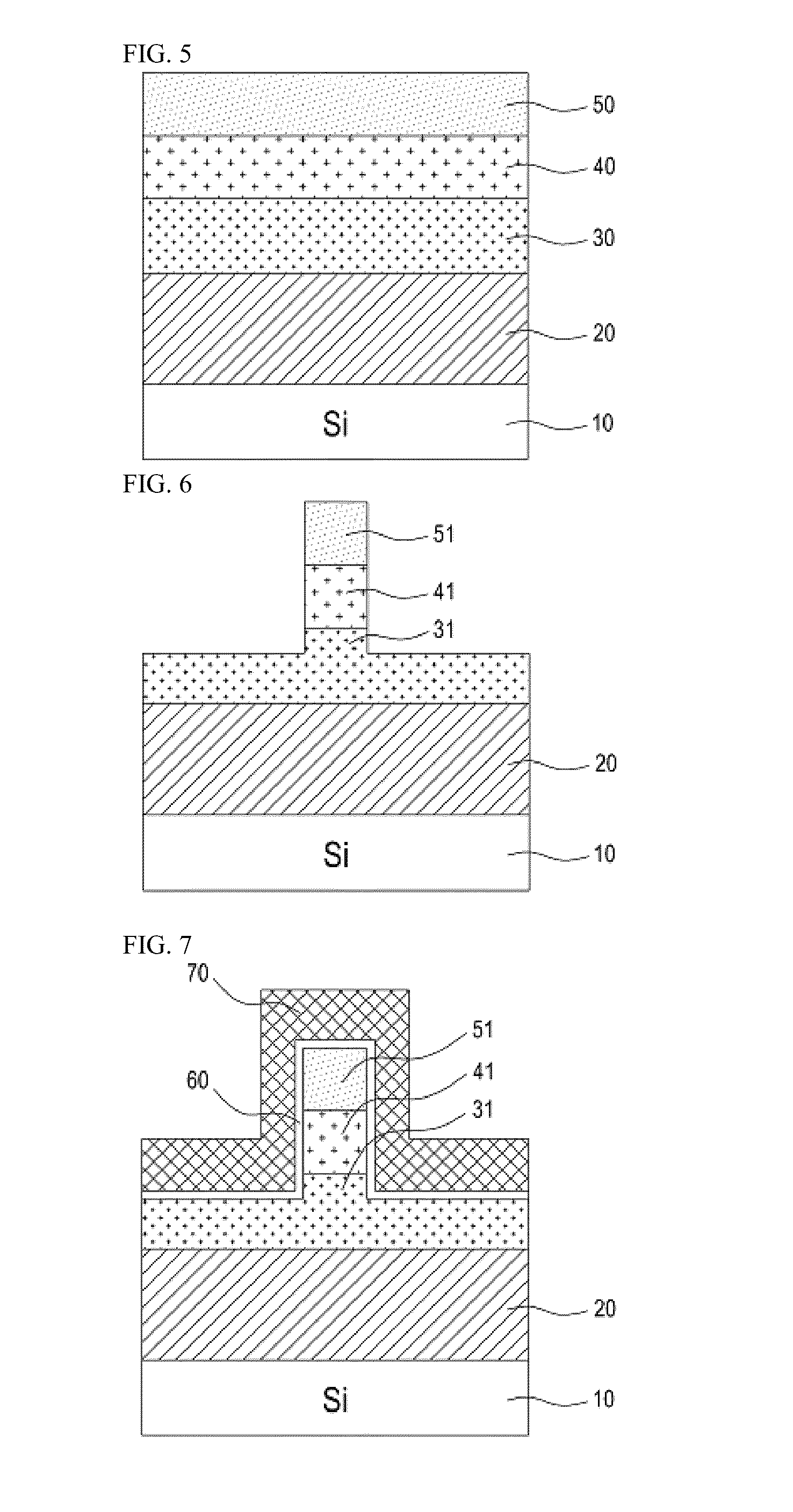Compound tunneling field effect transistor integrated on silicon substrate and method for fabricating the same
a tunneling field effect transistor and silicon substrate technology, applied in the direction of diodes, semiconductor devices, electrical devices, etc., can solve the problems of reducing the size of the smaller device, complicated process, and reaching the limi
- Summary
- Abstract
- Description
- Claims
- Application Information
AI Technical Summary
Benefits of technology
Problems solved by technology
Method used
Image
Examples
embodiment 1
on a Device Structure
[0073]A compound tunneling field effect transistor according to Embodiment 1 of the present invention, as commonly shown in FIGS. 8 and 16, basically comprising: a silicon substrate 10; a source region 31 or 32 formed of a first semiconductor material having a lattice constant difference with silicon 5% or less, a bandgap at least 0.4 electron volts (eV) narrower than that of silicon and a first conductive type on the silicon substrate 10; a channel region 41 or 42 formed of a second semiconductor material having a lattice constant difference with the first semiconductor material 2% or less, a bandgap wider than that of the first semiconductor material and electron mobility at least 5 times higher than that of silicon on the source region 31 or 32; a drain region 51 or 52 formed of a third semiconductor material having a lattice constant difference with the second semiconductor material 1% or less, a bandgap wider than or equal to that of the second semiconducto...
embodiment 2
on a Device Structure
[0103]A compound tunneling field effect transistor according to Embodiment 2 of the present invention, as commonly shown in FIGS. 21, 27 and 33, basically comprising: a silicon substrate 10; a source region 33 or 34 formed of a first semiconductor material having a lattice constant difference with silicon 5% or less, a bandgap at least 0.4 electron volts (eV) narrower than that of silicon and a first conductive type on the silicon substrate 10; a channel region 43 or 45 formed of a second semiconductor material having a lattice constant difference with the first semiconductor material 2% or less, a bandgap wider than that of the first semiconductor material and electron mobility at least 5 times higher than that of silicon being contacted laterally to the source region 33 or 34; a drain region 53 or 55 formed of a third semiconductor material having a lattice constant difference with the second semiconductor material 1% or less, a bandgap wider than or equal to ...
embodiment 3
on a Device Structure
[0111]A compound tunneling field effect transistor according to Embodiment 3 of the present invention, as commonly shown in FIGS. 8, 16, 21 and 27, in the compound tunneling field effect transistor according to Embodiments 1 and 2, further comprises a buffer layer 20 formed of silicon germanium (SiGe) between the silicon substrate 10 and the source region 31, 32, 33 or 34. Wherein the first semiconductor material is germanium (Ge), and wherein the second and third semiconductor materials are gallium arsenide (GaAs).
[0112]By the above configuration, Embodiment 3 has the effects according to Embodiments 1 and 2 and additional effects as the following.
[0113]By the further formation of the buffer layer 20 with silicon germanium (SiGe) between the silicon substrate 10 and the source region 31, 32, 33 or 34, the source region 31, 32, 33 or 34 can be unformly formed of germanium (Ge) overcoming a lattice constant difference with the first semiconductor material (Ge) on...
PUM
 Login to View More
Login to View More Abstract
Description
Claims
Application Information
 Login to View More
Login to View More - R&D
- Intellectual Property
- Life Sciences
- Materials
- Tech Scout
- Unparalleled Data Quality
- Higher Quality Content
- 60% Fewer Hallucinations
Browse by: Latest US Patents, China's latest patents, Technical Efficacy Thesaurus, Application Domain, Technology Topic, Popular Technical Reports.
© 2025 PatSnap. All rights reserved.Legal|Privacy policy|Modern Slavery Act Transparency Statement|Sitemap|About US| Contact US: help@patsnap.com



